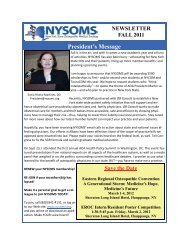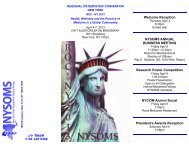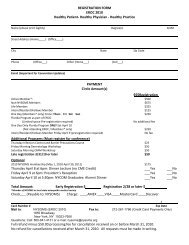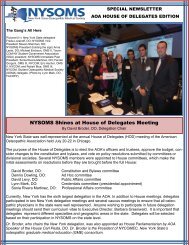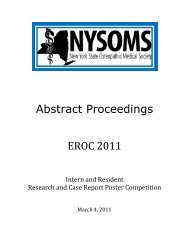Lower Extremity Neuropathies
Lower Extremity Neuropathies
Lower Extremity Neuropathies
Create successful ePaper yourself
Turn your PDF publications into a flip-book with our unique Google optimized e-Paper software.
<strong>Lower</strong> <strong>Extremity</strong><br />
<strong>Neuropathies</strong><br />
March 25, 2009
Learning Objectives<br />
� Describe and Discuss Common<br />
entrapment neuropathies of the lower<br />
extremity<br />
� Analyze the relevant anatomy of these<br />
neuropathies<br />
� Review possible Osteopathic treatments<br />
for these neuropathies
Definitions<br />
� Peripheral Neuropathy<br />
� Compression Neuropathy<br />
� Entrapment Neuropathy<br />
� “Any of a group of neuropathies,…,in which a<br />
peripheral nerve is injured by compression in its<br />
course through a fibrous or osseofibrous tunnel<br />
or at a point where it abruptly changes its course<br />
through deep fascia over a fibrous or muscular<br />
band.” Dorlands, 27th
Definitions<br />
� Peripheral Neuropathy<br />
� Focal<br />
� General<br />
� Disease<br />
� Drugs<br />
� Genetic<br />
� Nutrition<br />
� Environmental
Definitions<br />
� Radiculopathy<br />
� Specialized form of neuropathy which occurs<br />
at the root (radicule) of the nerve as it leaves<br />
the spinal cord.<br />
� Segmental Neuropathy<br />
� AKA Segmental demyelinating neuropathy<br />
� Loss of myelin sheath, changes conduction<br />
pattern
Case #1<br />
� 72 year old dentist, complains of dragging<br />
his right toe. Mild pain in his right knee<br />
� Hx: Started about three weeks ago. Is<br />
progressive.<br />
� Weekend previous, was washing van,<br />
moving some furniture to close summer<br />
cottage, not much else.
Case #1<br />
� You think (differential)<br />
� Diabetes?<br />
� Alcoholism (B12 def?)<br />
� Sitting position, legs<br />
crossed?<br />
� Recent wt loss<br />
� No history, no recent<br />
changes<br />
� One drink daily in<br />
evening x 30 years<br />
� Rarely crosses legs,<br />
usually ankles if at all<br />
� 155# x 25 years
Case #1<br />
� Washing van?<br />
� He is about 5‟8”,<br />
stretching to get<br />
top of windows<br />
and parts of roof.<br />
On tiptoes…
Case #1<br />
� On Tiptoes…<br />
� Biceps femoris<br />
contracts<br />
� Soleus contracts<br />
� Gastroc contracts<br />
� Compress nerve<br />
� Loss of<br />
dorsiflexion
Common Peroneal<br />
� Divides into Deep &<br />
Superficial<br />
� Deep innervates<br />
� Tibialis Anterior<br />
� Extensor digitorum<br />
longus/brevis<br />
� Extensor hallicus<br />
longus
Innervation of Anterior Compartment = Deep Peroneal
Common Peroneal Compression<br />
� Third most common compression<br />
neuropathy<br />
� Etiology<br />
� Leg hooked over rail (bedridden, comatose,<br />
post operative<br />
� Strawberry Pickers palsy<br />
� Time spent in squatting position<br />
� Ankle Sprains (always check fibular head)
Common Peroneal Compression<br />
� New Meditators or New to Yoga<br />
� “lotus position”<br />
� Natural Childbirth<br />
� Time spent squatting<br />
� Holding knees (wrist can compress at fibular<br />
head)<br />
� Idiopathic
Common Peroneal Compression<br />
� Treatment?<br />
� Posterior fibular head<br />
� Muscle Energy on gastroc/soleus<br />
� Muscle Energy on Biceps femoris<br />
� How do you know when you are done?<br />
� Pain resolves<br />
� Dorsiflexion returns to normal
Case #2<br />
� A 34 year old female stockbroker comes to your<br />
office with a complaint of foot pain. On<br />
weekends she plays volleyball with a few of her<br />
old teammates from college in an amateur<br />
league.<br />
� The pain started the week after a teammate<br />
came down on her foot. She did not notice much<br />
pain until later in the week.
Case #2<br />
� She denies any diabetic, alcohol,<br />
nutritional or other problem.<br />
� Systemic signs of disease are absent.<br />
� On examination<br />
� Patellar reflex intact<br />
� Achilles reflex intact but when you dorsiflex<br />
her foot, she winces.
Case #2<br />
� You pursue the pain and she notes that the tap<br />
was not painful but when your hand grasped her<br />
foot, the pain was on the dorsum of the foot.<br />
� You test your hypothesis by plantar-flexing her<br />
foot which exacerbates her pain.<br />
� Sensory evaluation of the foot reveals<br />
numbness between the first and second toes<br />
and not much further.
Anterior Tarsal Tunnel Syndrome<br />
� You further localize the compression and<br />
the nerve by dorsiflexing the foot and then<br />
asking her to dorsiflex her big toe.<br />
Attempting to do so exacerbates the pain.<br />
� Her history is positive for pain at night,<br />
which has been waking her from sleep<br />
more frequently recently.
Anterior Tarsal<br />
Tunnel Syndrome<br />
� Which nerve is it?<br />
� Medial branch of the deep<br />
peroneal?<br />
� Lateral branch of the deep<br />
peroneal?<br />
� Which nerve innervates<br />
the extensor digitorum<br />
brevis?<br />
� Where is the problem?
Anterior Tarsal<br />
Tunnel Syndrome<br />
The Problem:<br />
Compression of the nerve at the<br />
inferior flexor retinaculum<br />
-injury<br />
-talonavicular dysfunction<br />
-prolonged plantar flexion<br />
-compression from shoes<br />
shoe straps<br />
shoes tied too tight
Summary:<br />
Anterior Tarsal Tunnel<br />
Syndrome
Treatment<br />
� Remove compressive forces<br />
� Myofascial release of inferior flexor<br />
retinaculum<br />
� Release talonavicular joint – Traction tug<br />
� Hiss whip for navicular, cuneiforms, 1 st –<br />
2 nd metatarsal
Tarsal Tunnel Syndrome<br />
(NOT anterior tarsal syndrome)<br />
� Difficult Diagnosis<br />
� Pain on plantar surface of the foot<br />
� Not very specific<br />
� Does not affect large foot muscles<br />
� Difficult to test toe intrinsics…<br />
� Extrinsics compensate very well<br />
� May be described as burning, itching,<br />
tightness, numbness.<br />
� Gait seldom affected
Tarsal Tunnel Syndrome<br />
Calcaneal branches of posterior<br />
tibial<br />
-many variations<br />
some branch above retinaculum<br />
some branch through retinaculum<br />
very few branch distal to<br />
retinaculum.
Tarsal Tunnel Syndrome<br />
� Etiology<br />
� Trauma to medial malleolus – MVA<br />
� Congenital<br />
� Autoimmune<br />
� RA, Ankylosing spondylitis<br />
� Diabetes<br />
� Tumors<br />
� Lifestyle (long periods of standing…)
Treatment<br />
� Tibial ligaments/fascia<br />
� May be posterior to normal position<br />
� Talo-calcaneus tx<br />
� Stretch the ligaments<br />
� Roof of the „tunnel‟<br />
� Talonavicular
Saphenous Nerve Syndrome<br />
� Athletes<br />
� Body builders<br />
� Femoral Arteriography<br />
� Vascular surgery<br />
� Higher than average – thrombophlebitis<br />
� Inflammation causes nerve & vein to expand<br />
in canal, increases compression
Saphenous Nerve Syndrome<br />
Saphenous N<br />
Branch of Femoral<br />
-separates just below inguinal<br />
ligament<br />
-may be compressed at vasoadductor<br />
membrane
Saphenous Nerve Syndrome<br />
Saphenous Nerve Compression<br />
-Sartorius<br />
-Between Adductor longus &<br />
vastus medialis<br />
Saphenous Nerve below knee<br />
-infrapatellar branch<br />
-medial leg and foot –<br />
descending branch
Saphenous Nerve Syndrome<br />
� Clinical symptoms<br />
� Medial leg pain when walking<br />
� Medial knee pain<br />
� May be painful on resisted adduction<br />
� Tinel‟s anywhere along path of nerve
Treatment<br />
� Muscle energy<br />
� Sartorius<br />
� Adductor longus<br />
� Vastus medialis<br />
� Fascial Treatments<br />
� Inguinal area<br />
� Vaso-adductor membrane<br />
� Medial knee fascia
Meralgia Paresthetica<br />
� Compression of the lateral femoral cutaneous<br />
nerve, usually under the inguinal ligament<br />
� Sensory only<br />
� Symptoms include<br />
� Numbness on anterolateral thigh<br />
� Burning pain in same area<br />
� Hypesthesia to the point of not putting anything in the<br />
pockets over the area<br />
� Late sign: trophic skin changes
Meralgia Paresthetica<br />
� Causes<br />
� Very intense athletics<br />
� Obesity<br />
� Tight girdle, tight clothing<br />
� Seat belt misplacement or post accident<br />
� Anatomic anomaly, ie through the sartorius
Meralgia Paresthetica<br />
� Treatment<br />
� Relieve tension in Pelvic Diaphragm<br />
� Muscle energy to Psoas<br />
� Myofascial release to inguinal canal<br />
� Find and fix lumbar, innominate and sacral<br />
problems<br />
� Muscle energy or MFR to sartorius
Meralgia Paresthetica<br />
� Usual area of<br />
entrapment is at<br />
inguinal canal
Possible distribution areas
Taken from a lecture by Jim Bailey, MD<br />
http://www.utmem.edu/gim/smalltalks/le-neuropathy.pdf<br />
Sciatic Neuropathy<br />
Cause: Trauma at sciatic notch or gluteal<br />
region (hip dislocation, fracture, or<br />
replacement),<br />
prolonged bed rest, deep-seated pelvic mass,<br />
piriformis syndrome<br />
Sxs: <strong>Lower</strong> leg pain and<br />
weakness<br />
Signs: Sensory loss in peroneal, tibial, and<br />
sural territories, normal patellar reflex, foot<br />
drop less common<br />
Tarsal Tunnel Syndrome –Tibial nerve entrapment<br />
Cause: Fracture or dislocation of talus, calcaneus, medial<br />
malleolus, rheumatoid arthritis, tumor, diabetes alone?<br />
Sxs: Aching, burning, numbness, tingling on plantar foot,<br />
distal foot, toes, and occasionally heel, paresthesias<br />
and/or sensory loss<br />
Signs: Positive Tinel's sign over nerve posterior to medial<br />
malleolus; sensory loss on plantar foot; atrophy of foot<br />
muscles if severe<br />
Femoral Neuropathy<br />
Cause: Mid thigh or pelvis trauma (hip, pelvis or femur fracture,<br />
mass, ischemic nerve infarction or, hip replacement, lithotomy<br />
position, diabetes mellitus)<br />
Sxs: Leg pain, Quadriceps weakness and sensory loss over<br />
thigh and shin<br />
Signs: sensory loss, decreased patellar reflex<br />
Lateral cutaneous nerve of thigh<br />
Meralgia Paresthetica<br />
Cause: Compression of lateral femoral cutaneous<br />
nerve at inguinal ligament Obesity, tight fitting belts,<br />
idiopathic<br />
Sxs: Paresthesias and pain radiating down the lateral<br />
thigh to knee, paresthesias and/or sensory loss<br />
Signs: Minimal sensory loss<br />
Common Peroneal Neuropathy<br />
Cause: Compression just below fibular head from prolonged<br />
lying, leg crossing, squatting, leg cast<br />
Sxs: Foot drop, paresthesias and/or sensory loss<br />
Signs: Foot drop/weakness on foot dorsiflexion and eversion;<br />
sensory loss on dorsum of foot<br />
Distal Peroneal Neuropathy<br />
Cause: Trauma to dorsum of foot or ankle/distal peroneal nerve, tightfitting<br />
shoe rim or strap<br />
Sxs: Dorsal foot paresthesias and/or sensory loss<br />
Signs: Minimal sensory loss
References<br />
� Minoo Hadjari Hollis, MD, David E Lemay, MD, Robert P Jensen, MD. Nerve Entrapment Syndromes of the<br />
<strong>Lower</strong><br />
� <strong>Extremity</strong>, emedicine<br />
� Goroll AH, May LA, Mulley AG. Primary Care Medicine. READ CHAPTER 154 “Approach to Minor<br />
Orthopedic Problems<br />
� of the Foot and Ankle”.<br />
� Seward B Rutkove, MD Overview of lower extremity peripheral nerve syndromes, UptoDate<br />
� Wieman TJ, Patel VG: Treatment of hyperesthetic neuropathic pain in diabetics. Decompression of the<br />
tarsal tunnel. Ann Surg 1995 Jun; 221(6): 660-4; discussion 664-5.<br />
� E. DiGiovanna S. Schiowitz, D. Dowling - An Osteopathic Approach to Diagnosis and Treatment Third<br />
Edition, Lippincott Williams & Wilkins





